Intel Core i7 3960X (Sandy Bridge E) Review: Keeping the High End Alive
by Anand Lal Shimpi on November 14, 2011 3:01 AM EST- Posted in
- CPUs
- Intel
- Core i7
- Sandy Bridge
- Sandy Bridge E
No Integrated Graphics, No Quick Sync
All of this growth in die area comes at the expense of one of Sandy Bridge's greatest assets: its integrated graphics core. SNB-E features no on-die GPU, and as a result it does not feature Quick Sync either. Remember that Quick Sync leverages the GPU's shader array to accelerate some of the transcode pipe, without its presence on SNB-E there's no Quick Sync.
Given the target market for SNB-E's die donor (Xeon servers), further increasing the die area by including an on-die GPU doesn't seem to make sense. Unfortunately desktop users suffer as you lose a very efficient way to transcode videos. Intel argues that you do have more cores to chew through frames with, but the fact remains that Quick Sync frees up your cores to do other things while SNB-E requires that they're all tied up in (quickly) transcoding video. If you don't run any Quick Sync enabled transcoding applications, you won't miss the feature on SNB-E. If you do however, this will be a tradeoff you'll have to come to terms with.
Tons of PCIe and Memory Bandwidth
Occupying the die area where the GPU would normally be is SNB-E's new memory controller. While its predecessor featured a fairly standard dual-channel DDR3 memory controller, SNB-E features four 64-bit DDR3 memory channels. With a single DDR3 DIMM per channel Intel officially supports speeds of up to DDR3-1600, with two DIMMs per channel the max official speed drops to 1333MHz.
With a quad-channel memory controller you'll have to install DIMMs four at a time to take full advantage of the bandwidth. In response, memory vendors are selling 4 and 8 DIMM kits specifically for SNB-E systems. Most high-end X79 motherboards feature 8 DIMM slots (2 per channel). Just as with previous architectures, installing fewer DIMMs is possible, it simply reduces the peak available memory bandwidth.
Intel increased bandwidth on the other side of the chip as well. A single SNB-E CPU features 40 PCIe lanes that are compliant with rev 3.0 of the PCI Express Base Specification (aka PCIe 3.0). With no PCIe 3.0 GPUs available (yet) to test and validate the interface, Intel lists PCIe 3.0 support in the chip's datasheet but is publicly guaranteeing PCIe 2.0 speeds. Intel does add that some PCIe devices may be able to operate at Gen 3 speeds, but we'll have to wait and see once those devices hit the market.
The PCIe lanes off the CPU are quite configurable as you can see from the diagram above. Users running dual-GPU setups can enjoy the fact that both GPUs will have a full x16 interface to SNB-E (vs x8 in SNB). If you're looking for this to deliver a tangible performance increase, you'll be disappointed:
| Multi GPU Scaling - Radeon HD 5870 CF | |||||
| Max Quality, 4X AA/16X AF | Metro 2033 (19x12) | Crysis: Warhead (19x12) | Crysis: Warhead (25x16) | ||
| Intel Core i7 3960X (2 x16) | 1.87x | 1.80x | 1.90x | ||
| Intel Core i7 2600K (2 x8) | 1.94x | 1.80x | 1.88x | ||
Modern GPUs don't lose much performance in games, even at high quality settings, when going from a x16 to a x8 slot.
I tested PCIe performance with an OCZ Z-Drive R4 PCIe SSD to ensure nothing was lost in the move to the new architecture. Compared to X58, I saw no real deltas in transfers to/from the Z-Drive R4:
| PCI Express Performance - OCZ Z-Drive R4, Large Block Sequential Speed - ATTO | ||||
| Intel X58 | Intel X79 | |||
| Read | 2.62 GB/s | 2.66 GB/s | ||
| Write | 2.49 GB/s | 2.50 GB/s | ||
The Letdown: No SAS, No Native USB 3.0
Intel's current RST (Rapid Story Technology) drivers don't support X79, however Intel's RSTe (for enterprise) 3.0 will support the platform once available. We got our hands on an engineering build of the software, which identifies the X79's SATA controller as an Intel C600:
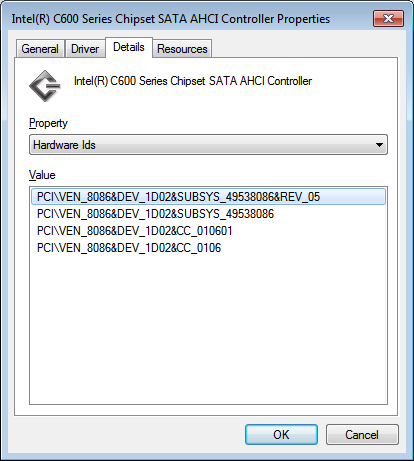
Intel's enterprise chipsets use the Cxxx nomenclature, so this label makes sense. A quick look at Intel's RSTe readme tells us a little more about Intel's C600 controller:
SCU Controllers:
- Intel(R) C600 series chipset SAS RAID (SATA mode)
Controller
- Intel C600 series chipset SAS RAID ControllerSATA RAID Controllers:
- Intel(R) C600 series chipset SATA RAID ControllerSATA AHCI Controllers:
- Intel(R) C600 series chipset SATA AHCI Controller
As was originally rumored, X79 was supposed to support both SATA and SAS. Issues with the implementation of the latter forced Intel to kill SAS support and go with the same 4+2 3Gbps/6Gbps SATA implementation 6-series chipset users get. I would've at least liked to have had more 6Gbps SATA ports. It's quite disappointing to see Intel's flagship chipset lacking feature parity with AMD's year-old 8-series chipsets.
I ran a sanity test on Intel's X79 against some of our H67 data for SATA performance with a Crucial m4 SSD. It looks like 6Gbps SATA performance is identical to the mainstream Sandy Bridge platform:
| 6Gbps SATA Performance - Crucial m4 256GB (FW0009) | ||||||
| 4KB Random Write (8GB LBA, QD32) | 4KB Random Read (100% LBA, QD3) | 128KB Sequential Write | 128KB Sequential Read | |||
| Intel X79 | 231.4 MB/s | 57.6 MB/s | 273.3 MB/s | 381.7 MB/s | ||
| Intel Z68 | 234.0 MB/s | 59.0 MB/s | 269.7 MB/s | 372.1 MB/s | ||
Intel still hasn't delivered an integrated USB 3.0 controller in X79. Motherboard manufacturers will continue to use 3rd party solutions to enable USB 3.0 support.


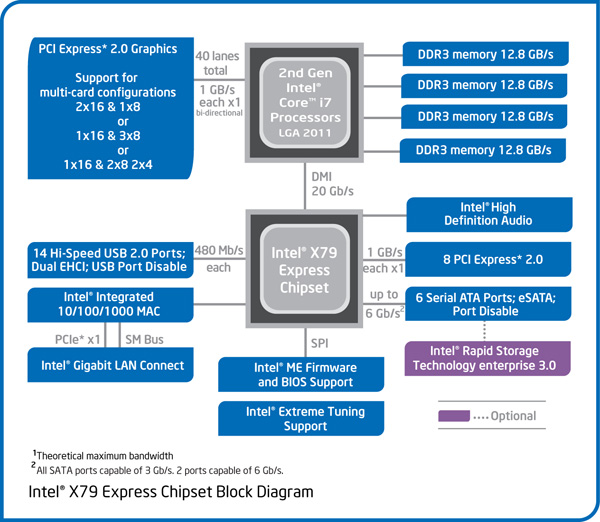
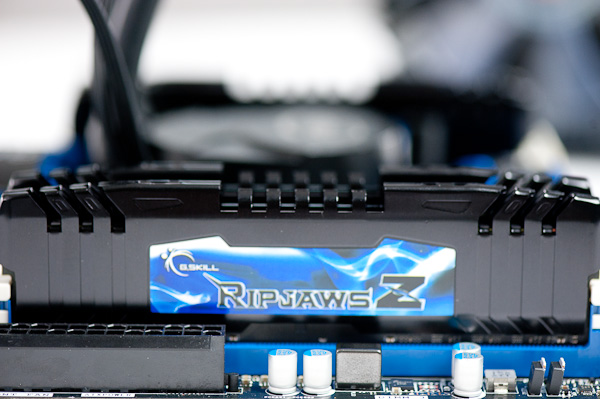
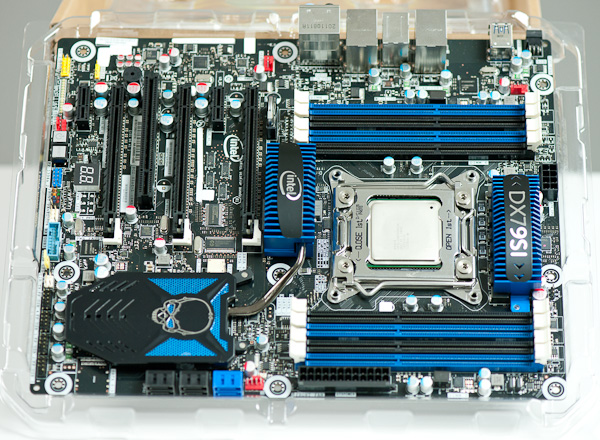
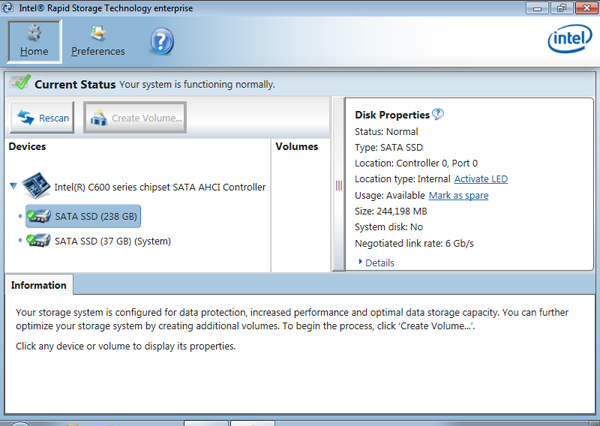








163 Comments
View All Comments
xpclient - Monday, November 14, 2011 - link
I read Intel is not going to release AHCI/SATA/Matrix RAID drivers for 32-bit Windows XP for X79. Why??? Without AHCI, performance is going not going to be optimal. For those that dual boot with Windows 7, this means changing the settings from AHCI to IDE every time you boot into XP.Rick83 - Monday, November 14, 2011 - link
And I heard that USB 3 had no drivers for my Win95 D either!B3an - Monday, November 14, 2011 - link
Because no one in there right mind would buy this high-end platform then use a decade old POS operating system. Waste of Intels time to support it and XP needs to die already.XP will take little advantage of SSD's or even new HDD's properly, some drives wont even work at all on it, and it lacks the same level of support and performance for CPU features and multiple cores that Win7 has. If you really need to run some old software just use XP mode in Win 7 or use VM software.
xpclient - Monday, November 14, 2011 - link
Are you not aware of multi-core benchmarks? http://www.infoworld.com/t/platforms/generation-ga... Windows 7 does not perform faster than XP until you reach eight cores or higher.Peskarik - Monday, November 14, 2011 - link
"Just as with previous architectures, installing fewer DIMMs is possible, it simply reduces the peak available memory bandwidth."So, I have:
Asus P8Z68-V Pro/Gen3 motherboard
Intel Core i7 2600K
Corsair Vengeance Red, 2x4GB, DDR3-1600, CL9@1.5V
When I am in BIOS the memory is set to 1333Mhz, and I had to manually set it to 1600, though I am not sure whether it actually runs at this speed (how can I check?).
Does the above sentence from the article mean that with 8GB RAM I do not have full memory bandwidth and that if I install 16GB RAM (I have 4 slots) then I have full 1600Mhz automatically?
kr1s69 - Monday, November 14, 2011 - link
Sandy Bridge E is quad channel and so needs 4 DIMM's to obtain the peak bandwidth. Your Sandy Bridge system is dual channel and so you need 2 DIMM's to obtain the peak bandwidth. This is what you currently have installed, so no need to worry.The statement you quoted is basically saying this motherboard would boot with less than 4 DIMM's installed, that is all.
Sandy Bridge defaults to 1333Mhz but you can change this in the BIOS to 1600Mhz as you have done. You can download CPU-Z to confirm what speed your RAM is set to.
piroroadkill - Monday, November 14, 2011 - link
Set the O/C Profile to X.M.P.This uses the eXtreme Memory Profile provided by your RAM. Basically, standard SPD ratings don't go as high as 1600. XMP is required for this, it's a custom Intel extension to SPD.
piroroadkill - Monday, November 14, 2011 - link
Although it's supposed to work, in my experience I had to set my RAM to DDR3-1600 anyway. Ho hum.lukarak - Monday, November 14, 2011 - link
This is not a great update. I wonder if 2011 will be the socket for ivy bridge E. If that's the case, it could be a good buy for somebody transitioning from an older system.dlitem - Monday, November 14, 2011 - link
There were some rumors / news circulating earlier that VT-d is bugged. Is that actually the case? SB-E is The workstation platform and losing VT-d is kind of a shame, as there actually are people who might have benefited from it.Also, a lot of us are still running our trusty 3 year old Quad-Bloomfields that have served us so well, so including one LGA1366 Quad-core would have be a really nice thing.